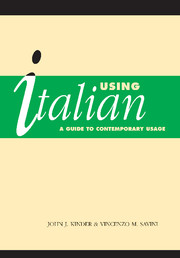Book contents
- Frontmatter
- Contents
- Preface and acknowledgments
- Abbreviations
- 1 Varieties of language
- WORDS AND THEIR MEANINGS
- 2 Misleading similarities
- 3 Fields of meaning – “Synonyms”
- 4 Complex verbal expressions
- 5 Affective suffixes
- 6 Idioms, similes, and proverbs
- 7 Personal names
- 8 Geographical and astronomical names
- 9 Abbreviations and acronyms
- 10 Latin expressions and sayings
- 11 Grammatical terms
- 12 Numerals and telephone conventions
- 13 Measurement
- THE CLAUSE – combining words
- THE SENTENCE – combining clauses
- TEXTS AND THEIR STRUCTURE
- Bibliography
- Italian word index
- Grammar index
10 - Latin expressions and sayings
Published online by Cambridge University Press: 05 June 2012
- Frontmatter
- Contents
- Preface and acknowledgments
- Abbreviations
- 1 Varieties of language
- WORDS AND THEIR MEANINGS
- 2 Misleading similarities
- 3 Fields of meaning – “Synonyms”
- 4 Complex verbal expressions
- 5 Affective suffixes
- 6 Idioms, similes, and proverbs
- 7 Personal names
- 8 Geographical and astronomical names
- 9 Abbreviations and acronyms
- 10 Latin expressions and sayings
- 11 Grammatical terms
- 12 Numerals and telephone conventions
- 13 Measurement
- THE CLAUSE – combining words
- THE SENTENCE – combining clauses
- TEXTS AND THEIR STRUCTURE
- Bibliography
- Italian word index
- Grammar index
Summary
Some of the most common Latin expressions in use in today's Italian are listed in the following tables. (See also section 9.1 for Latin abbreviations.)
note that, in the Italian tradition, Latin is pronounced according to the rules of modern Italian, except for the diphthongs “ae” and “oe,” read [ε] – e.g. ex aequo [εgz'εkwo/εks'/εkwo] – and the group “ti” followed by vowel, which is pronounced [tsj] – e.g. a fortiori, [a for'tsjɔri]. In particular, “h” is always silent – e.g. ad hoc [ad ɔk] – and “j” is pronounced [j] – e.g. Juventus [ju'vεntus].
Latin expressions
For some of these expressions the boundary between Latin and Italian is somewhat blurred, at least in most speakers' perception. In a case like nota bene, the argument in favour of an Italian reading is quite strong (to the point that this expression has not been included here as Latin); in others, such as grosso modo, the confusion arises from their widespread use and the existence of similar Italian words.
The following expressions are used as adjectives and/or adverbs, unless otherwise indicated. An English explanation of the Italian use of each expression has been given. A common Italian alternative has also been provided whenever available.
The symbol # indicates a similar use of the same expression in English, whereas the exclamation mark! warns that there are differences between Italian and English in their use of the same (or similar) Latin expression.
- Type
- Chapter
- Information
- Using ItalianA Guide to Contemporary Usage, pp. 217 - 220Publisher: Cambridge University PressPrint publication year: 2004



